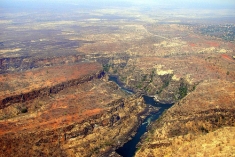Keeping the Conservation Promise

What started as an international effort to save Ramesses II’s Abu Simbel temple from the waters of the Aswan High Dam in Egypt – by relocating the temple piece by piece – is now a UN convention that seeks to prevent the destruction of precious cultural and natural heritage sites before it starts. At the time, over 90,000 Nubians had to be relocated, sometimes as far as 370 miles (600 km) from their homes, to make way for what would later be known as Lake Nasser. But the relocation of the temple was considered a success, and in 1972, the World Heritage Convention – a tribute to conservation – was ratified. Today, 189 countries have signed onto the convention. The World Heritage Centre now coordinates all UNESCO affairs related to the World Heritage Convention and they are in turn advised by IUCN and ICOMOS on natural and cultural sites, respectively.
This year’s annual Committee meeting, which will be held in St. Petersburg, Russia, from June 24 - July 6, will be a celebration of “40 years of preserving the world’s most outstanding places, which constitute our shared heritage” as noted by IUCN’s Director General Julia Marton-Lefèvre. It will also be a test of how far the Convention and its stakeholders are willing to go to address serious threats to these sites, which include mining, oil and gas exploration, and increasingly, large dam development. Will it allow politics to dictate conservation priorities, or will it be a gold standard in conservation by practicing harm prevention rather than (as in the case of Abu Simbel) harm mitigation?
Empowering local groups to help fulfill the promise
Recent activities by the World Heritage Centre offer a glimmer of hope that the direction it wishes the UNESCO Convention to take is one that is bound more by its founding principles than by the special interests of individual host countries. For instance, the Centre issued a public letter in response to the over 200 letters that were sent by members of International Rivers within just one week. In the letter, the Centre acknowledges the concerns expressed by our members, mentioned that many of these dam-threatened sites will be on the agenda at the 36th session, and announced that this year, it would be live-streaming the meeting for the first time.
In addition, it has for the first time published its draft decisions for the 36th session of the World Heritage Committee, which provide important updates on the state of conservation of these sites, and serve as critical inputs to the final decisions discussed and adopted by the Committee during the week it meets in June and July. Among these draft decisions are a series of strong recommendations for sites with major dam development, which include: the inscription of Lake Turkana (Kenya) on the List of World Heritage in Danger due to the threats it faces from the Gibe III Dam upstream; requests for the assessment of the cumulative impacts of dams in the Three Parallel Rivers (China) and Río Plátano (Honduras); and the implementation of mitigation measures for existing dams at La Amistad (Panama and Costa Rica).
Many of these decisions were thanks in large part to the information submitted by local organizations around the world, such as Friends of Lake Turkana in Kenya, Heng Duan Shan Society in China, and Asociación ANAI in Costa Rica, who have been spearheading the conservation and awareness-raising efforts for these sites for decades. In fact, without these local groups, UNESCO and the Centre would have no hope of knowing the state of conservation for all its 936 sites, particularly those located in developing countries that are truly under threat and in need of protection.

One of the biggest critiques of the UNESCO Convention is that it has no teeth to enforce its final decisions, largely because of a lack of funding, but also because enforcement is dependent on the political will of the host countries. However, if UNESCO were to seriously enlist the support and respect of local organizations on the frontlines of the conservation movement, it may yet have a chance to fulfill its conservation promise. These groups are also on the frontlines of promoting policy reform and a paradigm shift in the mindset of their fellow country-members, one that values long-term sustainability and conservation over the exploitation of natural resources for short-term profits.
Since enforcement of any UNESCO decisions on protection is ultimately the responsibility of the host government, UNESCO must find a way to further empower these local groups. This could involve creating a fund that brings representatives from local communities to its annual Committee sessions each year, or developing a network of local conservation groups that monitors these sites and sends status updates directly to UNESCO. Whatever improvements UNESCO decides to make this year regarding its World Heritage program, it will need the participation and support of these groups in order to successfully preserve the world’s most well-loved and invaluable sites for another 40 years.
- Download the 2012 draft decisions and state of conservation reports:
- State of conservation of the properties inscribed on the List of World Heritage in Danger, Documents 7A and 7A.Add
- State of conservation of World Heritage properties inscribed on the World Heritage List, Documents 7B and 7B.Add
- Read the UNESCO World Heritage Centre Director's response to letters from civil society
- View the winners of the 2012 World Heritage Rivers photo contest
- Learn more about individuals sites threatened by large dam development


